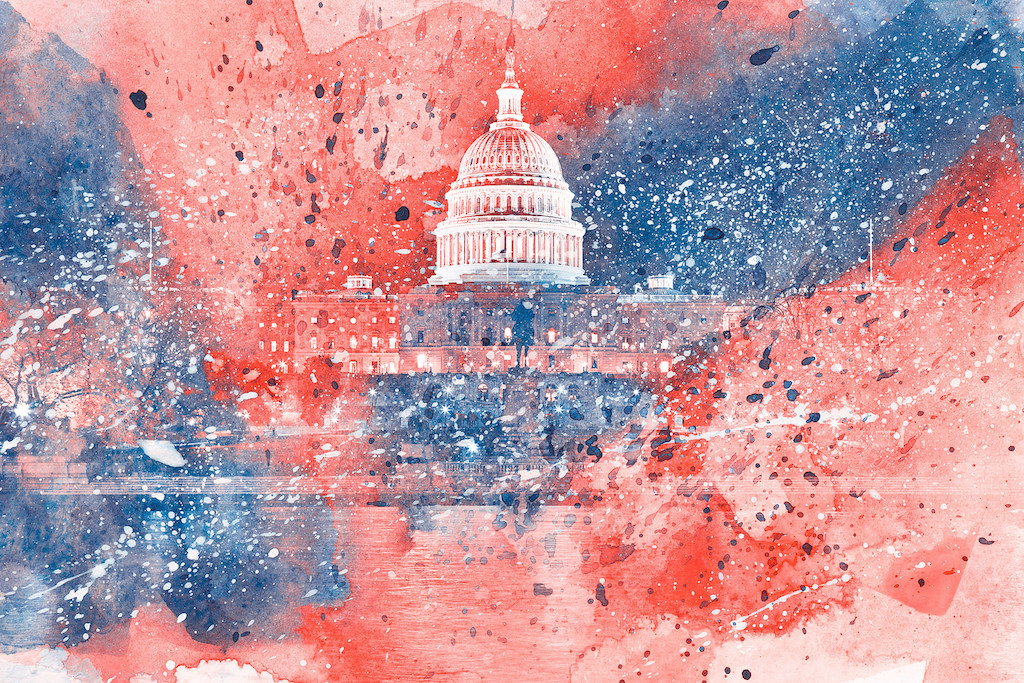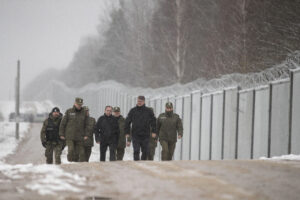Start Caring in 2018
It’s up to us to protest, resist, change, communicate and convince, to fight for life rather than its destruction in the age of Trump. Nicolas Raymond / CC 2.0
Nicolas Raymond / CC 2.0
Let’s start with the universe and work our way in. Who cares? Not them because as far as we know they aren’t there. As far as we know, no one exists in our galaxy or perhaps anywhere else but us (and the other creatures on this all-too-modest planet of ours). So don’t count on any aliens out there caring what happens to humanity. They won’t.
As for it — Earth — the planet itself can’t, of course, care, no matter what we do to it. And I’m sure it won’t be news to you that, when it comes to him — and I mean, of course, President Donald J. Trump, who reputedly has a void where the normal quotient of human empathy might be — don’t give it a second’s thought. Beyond himself, his businesses, and possibly (just possibly) his family, he clearly couldn’t give less of a damn about us or, for that matter, what happens to anyone after he departs this planet.
As for us, the rest of us here in the United States at least, we already know something about the nature of our caring. A Yale study released last March indicated that 70% of us — a surprising but still less than overwhelming number (given the by-now-well-established apocalyptic dangers involved) — believe that global warming is actually occurring. Less than half of us, however, expect to be personally harmed by it. So, to quote the eminently quotable Alfred E. Newman, “What, me worry?”
Tell that, by the way, to the inhabitants of Ojai and other southern California hotspots — infernos, actually — being reduced to cinders this December, a month that not so long ago wasn’t significant when it came to fires in that state. But such blazes should have been no surprise, thanks to the way fire seasons are lengthening on this warming planet. A burning December is simply part of what the governor of California, on surveying the fire damage recently, dubbed “the new normal” — just as ever more powerful Atlantic hurricanes, growing increasingly fierce as they pass over the warming waters of the Caribbean and the Gulf of Mexico on their way to batter the United States, are likely to be another new normal of our American world.
In the wake of the hottest year on record, we all now live on a new-normal planet, which means a significantly more extreme one. Perhaps it’s fitting, then, that the political version of that new normal involves a wildly overheated, overbearing, over-hyped, over-tweeted president (even if only 60-odd percent of us believe that he could truly harm us). He’s a man who, as the New York Times reported recently, begins to boil with doubt and disturbance if he doesn’t find himself in the headlines, the focus of cable everything, for even a day or two. He’s a man who seems to thrive only when the pot is boiling and when he’s the center of the universe. And what a world we’ve prepared for such an incendiary figure! (More on that later.)
We’re all now immersed in an evolving Trumpocalypse. In a sense, we were there even before The Donald entered the Oval Office. Just consider what it meant to elect a visibly disturbed human being to the highest office of the most powerful, potentially destructive nation on Earth. What does that tell you? One possibility: given the near majority of American voters who sent him to the White House, by campaign 2016 we were already living in a deeply disturbed country. And considering the coming of 1% elections, the growth of plutocracy, the blooming of a new Gilded Age whose wealth disparities must already be competitive with its nineteenth-century predecessor, the rise of the national security state, our endless wars (now turning “generational”), the increasing militarization of this country, and the demobilization of its people, to mention only a few twenty-first-century American developments, that should hardly be surprising.
Could Donald Trump Be the End of Evolutionary History?
Recently, as I was mulling over the extremity of this Trumpian moment, a depiction of evolution from my youth popped into my head. Sometimes back then, such illustrations, as I remember them, began with a fish-like creature flippering its way out of the water to be transformed into a reptile, but this one, known as the “March of Progress,” started with a hunched over ape-like creature. What followed were a series of figures that, left to right, grew ever more Homo-sapiens-like and ever more upright to the last guy, a muscular-looking fellow walking oh-so-erectly.
He, of course, was a proud specimen of us and we — it went without saying at the time — were the proud end of the line on this planet. We were it, progress personified! Even in my youth, however, we were also in the process of updating that evolutionary end point. At the height of the Cold War between the United States and the Soviet Union, the fear of another kind of end, one that might truly be the end of everything, had become a nightmarish commonplace in our lives.
One night almost 60 years ago, for instance, I can still vividly remember myself on my hands and knees crawling through the rubble of an atomically devastated city. It was just a nightmare, of course, but of a sort that was anything but uncommon for those of us growing up then. And there were times — especially during the Cuban Missile Crisis of 1962 — when those nuclear nightmares left the world of dreams and pop culture for everyday life. And even before that, if you were a child, you regularly experienced the fear of obliteration, as the air raid sirens wailed outside your classroom window, the radio on your teacher’s desk broadcast warnings from Conelrad, and you “ducked and covered” under your flimsy desk.
With the implosion of the Soviet Union in 1991, such fears receded, though they shouldn’t have, since by then, in a world of spreading nuclear states, we already knew about “nuclear winter.” What that meant should have been terrifying. A perfectly imaginable nuclear war, not between superpowers but regional powers like India and Pakistan, could put so much smoke, so many particulates, into the atmosphere as to absorb sunlight for years, radically cooling the planet and possibly starving out most of humanity.
Only in our moment, however, have such nuclear fears returned in a significant way. Under the circumstances, more than half a century after that March of Progress imagery became popular, if we were to provisionally update it, we might have to add a singularly recognizable figure to the far right side of that diorama (appropriately enough): a large but slightly stooped man with a jut-chin, a flaming face, and a distinctive orange comb-over.
Which brings us to a straightforward enough question: Could Donald Trump prove to be the end of evolutionary history? The answer, however provisionally, is that he could. At a minimum, right now he qualifies as the most dangerous man on the planet. He might indeed be the final stopping spot (or at least the person who pointed the way toward it) for human history, for everything that led to this moment, to us.
What Rough Beast, Its Hour Come Round at Last …?
Whatever you do, however, don’t just blame Donald Trump for this. He was simply the particularly unsettling version of Homo sapiens ushered into the White House on a backlash vote of dissatisfaction in 2016. When he got there, he unexpectedly found powers beyond compare awaiting him like so many loaded guns. As was true with the two presidents who preceded him, he automatically became not just the commander-in-chief of this country but its assassin-in-chief; that is, he found himself in personal control of an armada of drone aircraft that could be sent just about anywhere on Earth at his command to kill just about anyone of his choosing. At his beck and call, he also had the equivalent of what historian Chalmers Johnson once called the president’s own private army (now, armies): both the CIA irregulars Johnson was familiar with and the U.S. military’s vast, secretive Special Operations forces. Above all, however, he found himself in charge of the planet’s largest nuclear arsenal, weaponry that he and he alone could order into use.
In short, like this country’s other presidents since August 1945, he was fully weaponized and capable of singlehandedly turning this planet, or significant parts of it, into an instant inferno, a wasteland of — in his incendiary phrase in relation to North Korea — “fire and fury.” On January 20, 2017, in other words, he became the personification of a duck-and-cover planet (even though, as had been true since the 1950s, there was really nowhere to hide). It made no difference that he himself was woefully ignorant about the nature and power of such weaponry.
And speaking of planetary infernos, he also found himself weaponized when it came to a second set of instruments of ultimate destruction about which he was no less ignorant and to which he was even more in thrall. He brought to the Oval Office — Make America Great Again! — a nostalgia for his fossil-fuelized childhood world of the 1950s. Weaponized by Big Energy, he arrived prepared to ensure that the wealthiest and most powerful country on the planet would clear the way for yet more pipelines, fracking, offshore drilling, and just about every other imaginable form of exploitation of oil, natural gas, and coal (but not alternative energy). All of this was intended to create, as he proclaimed, a new “golden age,” not just of American energy independence but of “energy dominance” on a planetary scale. And here’s what that really means: through his executive orders and the decisions of the stunning range of climate deniers and Big Oil enthusiasts he appointed to key posts in his administration, he can indeed ensure that ever more greenhouse gas emissions from the burning of fossil fuels will enter the atmosphere in the years to come, creating the basis for another kind of apocalypse.
On the promotion of global warming in his first year in office, it’s reasonable to say, with a certain Trumpian pride, that the president has once again made the United States the planet’s truly “exceptional” nation. In November, only five months after President Trump announced that the U.S. would withdraw as soon as possible from the Paris climate agreement to fight global warming, Syria (of all countries) finally signed onto it, the last nation on Earth to do so. That meant this country was truly… well, you can’t say left out in the “cold,” not on this planet anymore, but quite literally exceptional in its single-minded efforts to ensure the destruction of the very environment that had for so long ensured humanity’s well-being and made the creation of those illustrations of evolutionary progress possible.
Still, you can’t just blame President Trump for this either. He’s not responsible for the ingenuity, that gift of evolution, that led us, wittingly in the case of nuclear weapons and (initially) unwittingly in the case of climate change, to take powers once relegated to the gods and place them in our own hands — as of January 20, 2017, in fact, in the hands of Donald J. Trump. Don’t blame him alone for the fact that the most apocalyptic moment in our history might come not via an asteroid from outer space, but from Trump Tower.
So here we are, living with a man whose ultimate urge seems to be to bring the world to a boil around himself. It’s possible that he might indeed be the first president since Harry Truman in 1945 to order the use of nuclear weapons. As Nobel Prize winner Beatrice Fihn, director of the International Campaign to Abolish Nuclear Weapons, recently commented, the world might be only “a tiny tantrum” away from nuclear war in Asia. At the very least, he may already be helping to launch a new global nuclear arms race in which countries from South Korea and Japan to Iran and Saudi Arabia could find themselves with world-ending arsenals, leaving nuclear winter in the hands of… well, don’t even think about it.
Now, imagine that amended evolutionary chart again or perhaps — in honor of The Donald’s recent announcement that the U.S. was recognizing Jerusalem as Israel’s capital — call to mind poet William Butler Yeats’s words about a world in which “the best lack all conviction, while the worst are full of passionate intensity,” while some “rough beast, its hour come round at last” is slouching “towards Bethlehem to be born.” Think then of what a genuine horror it is that so much world-ending power is in the hands of any single human being, no less such a disturbed and disturbing one.
Of course, while Donald Trump might represent the end of the line that began in some African valley so many millennia ago, nothing on this planet is graven in stone, not when it comes to us. We still have the potential freedom to choose otherwise, to do otherwise. We have the capacity for wonders as well as horrors. We have the ability to create as well as to destroy.
In the phrase of Jonathan Schell, the fate of the Earth remains not just in his hands, but in ours. If they, those nonexistent aliens, don’t care and the planet can’t care and the alien in the White House doesn’t give a damn, then it’s up to us to care. It’s up to us to protest, resist, and change, to communicate and convince, to fight for life rather than its destruction. If you’re of a certain age, all you have to do is look at your children or grandchildren (or those of your friends and neighbors) and you know that no one, Donald Trump included, should have the right to consign them to the flames. What did they ever do to end up in a hell on Earth?
2018 is on the horizon. Let’s make it a better time, not the end of time.
Your support is crucial…With an uncertain future and a new administration casting doubt on press freedoms, the danger is clear: The truth is at risk.
Now is the time to give. Your tax-deductible support allows us to dig deeper, delivering fearless investigative reporting and analysis that exposes what’s really happening — without compromise.
Stand with our courageous journalists. Donate today to protect a free press, uphold democracy and unearth untold stories.









You need to be a supporter to comment.
There are currently no responses to this article.
Be the first to respond.